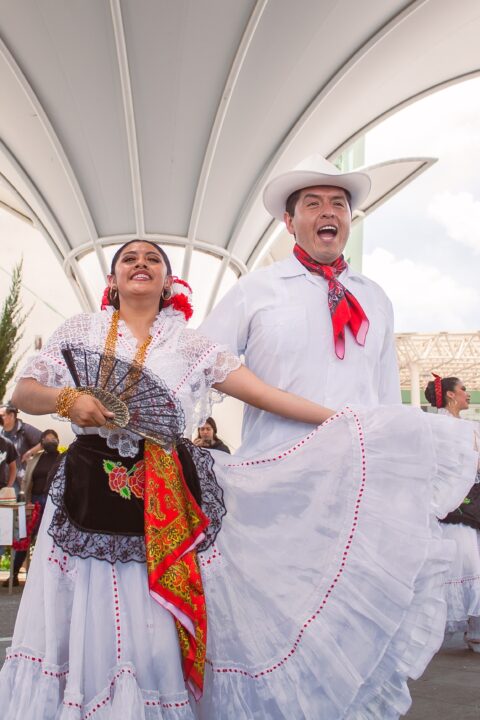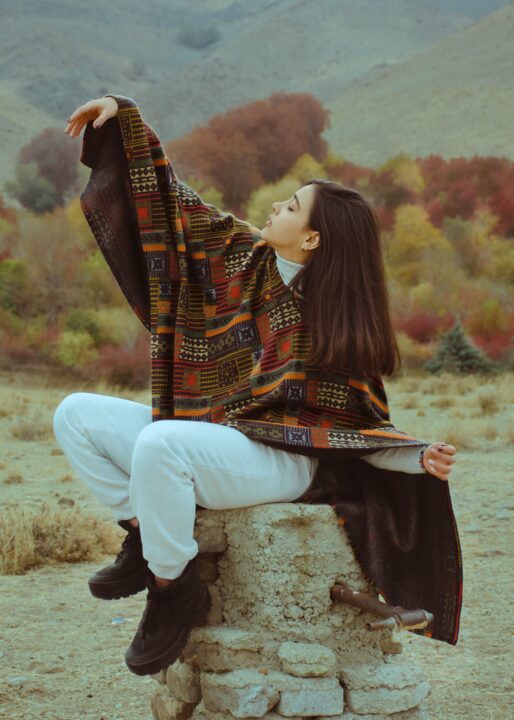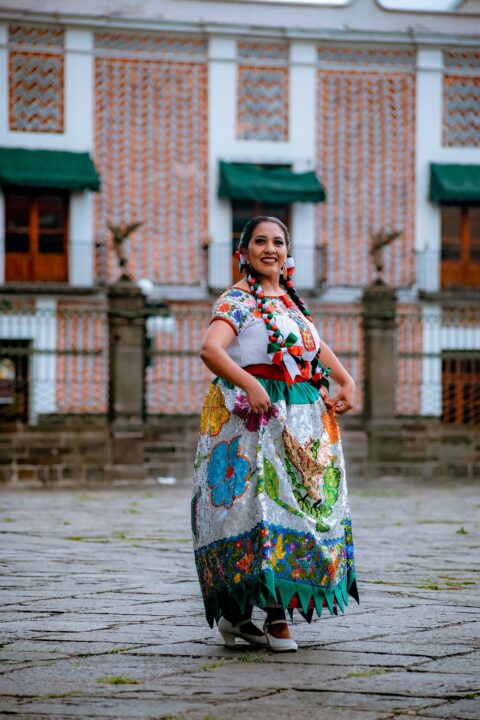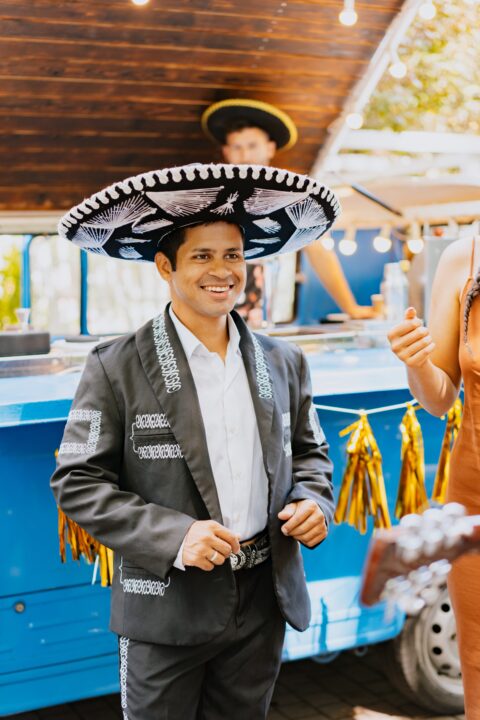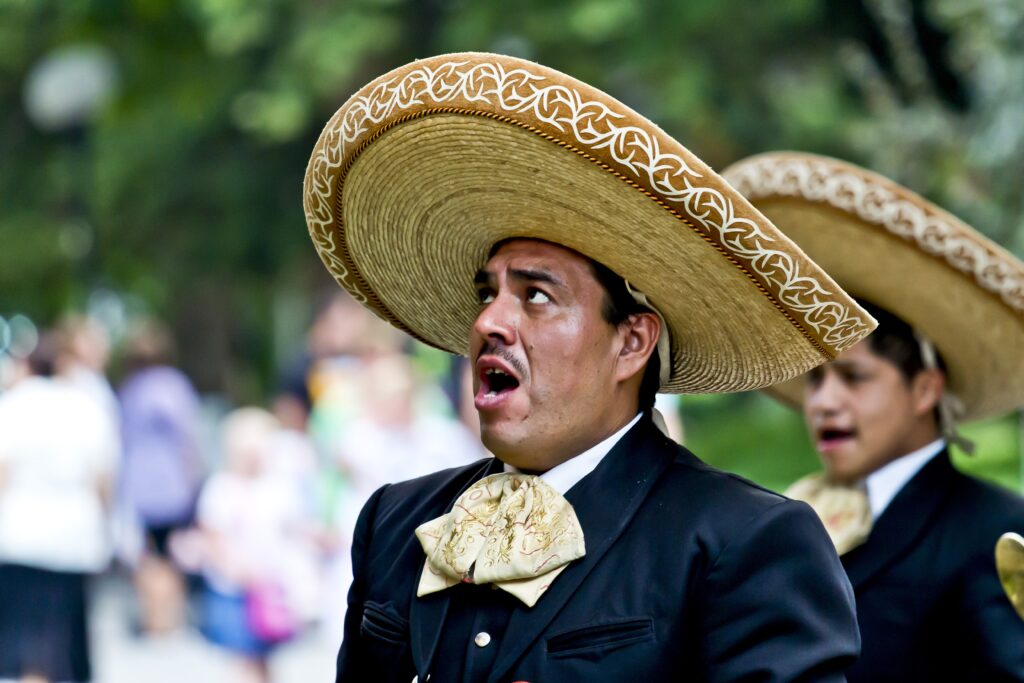Mexican national clothing is very bright and beautiful. Actually, there are many different designs of traditional costumes. Some of them are used for celebrations and holidays, some for ceremonies and some for festivals.
The main characteristics of Mexican national attire are sun protection, which is why the sombrero has such a wide brim and the clothing itself is made of natural materials, brightness; the fabric for garments is mostly colorful and heavily embroidered; a lot of colorful ribbons are used and moderate modesty.
The clothing is elegant, not shameless or vulgar at all; skirts are long, blouses are delicate; flowers are often used to beautify the costume, hairdo and headdress. Traditional Mexican clothing combines native and European elements.
The fibers of choice across the country are cotton, bark and agave (which were known and used by native Mexican pre-Hispanic civilizations to make their clothes), as well as wool and silk introduced by the Spanish later.
In the past, Mexican clothing was dyed with natural components found in local plants, but as soon as aniline dyes were brought from Europe, they became the first dye choice. Every corner of Mexico has its own traditional dress design. Mexican women wear very beautiful and feminine dresses.
1. Aztec Clothing
Aztec clothing in ancient times was often loose-fitting and colorful. The array of colors was due in part to the extensive trading network. While in their teens, Aztec women were taught to weave by hand, and primarily used cotton or ayate fiber. These ornate tunics are traditional garments that date back to the indigenous women of central Mexico and Central America.
2. Ichcahuipilli
A form of military armor, this Mesoamerican garment consisted of multiple layers of thick braided cotton, usually made stronger with brine. An effective Ichcahuipilli would slow and stop arrows. It is not uncommon to find a Huipil adorned with ribbons, lace, and other intricate designs.
It is a loose-fitting tunic, generally made from two or three rectangular pieces of fabric, which are then joined with stitching, ribbons, or fabric strips, with an opening for the head and, if the sides are sewn, openings for the arms. Traditional huipils, especially ceremonial ones, are usually made with fabric woven on a backstrap loom and are decorated with designs woven into the fabric, embroidery, ribbons, lace, and more.
However, some huipils are also made from commercial fabric. A huipil varies in length from a short blouse to a garment long enough to reach the floor. The style of traditional huipils generally indicates the ethnicity and community of the wearer, as each has its own methods of creating the fabric and decorations.
Ceremonial huipiles are suitable for weddings, burials, women of high rank and even to dress the statues of saints. The huipil has been worn by indigenous Mesoamerican women of both high and low social rank since well before the Spanish invasion.
A characteristic item of Aztec clothing, it remains the most common female indigenous garment still in use. It is most often seen in the Mexican states of Chiapas, Yucatán, Quintana Roo, Oaxaca, Tabasco, Campeche, Hidalgo, Michoacán (where it is called a huanengo), Veracruz and Morelos. In Central America, it is most often used among the Mayas in Guatemala.
3. Ponchos
-

a-ki, pexels, 14522229.jpg
Another iconic piece of clothing with origins in Central and South America is the Poncho. The use of the Poncho dates as far back as 500 B.C., before Spanish colonization. Initially designed out of materials such as wool or fleece, Ponchos were intended to keep the wearer warm and dry even in the wettest of climates.
Their exceptional effectiveness at this task led to a cheap plastic adaptation, as they have quickly become a must in wetter climates. Although most Ponchos today are practical in function, more expensive manufacturers have gone the route of creating fashionable statements through elaborate and unique designs.
4. Serape
Sarape is the only native addition to a man’s wardrobe. It is a vibrantly colored garment with a fringe. It represents a combination of Mayan elements and the Mexican poncho. It is usually made in the Mexican state of Coahuila. The gray area between the shawl, blanket, and poncho is where you’ll find the Serape.
Originally worn by farmers and shepherds in highland regions of the country, the Serape was woven with bleak browns and grays from wool or fleece. Serapes come in a variety of brightly colored materials.
Serape is also a rectangular woven blanket (no openings), though in more recent years it can also be used to refer to a very soft rectangular blanket with an opening in the middle for one’s head, similar to a poncho called gabán, or jorongo in Mexico. Modern variations of some serapes are made with matching hoods for head covering. The length varies, but the front and back normally reach knee height on an average person.
5. Baja Jacket
A Baja jacket (also known as a Mexican Baja hoodie, Baja sweatshirt, or drug rug) is a type of Mexican jacket with a single large pocket on the front and vents on the side. They are more commonly made out of a coarse woolen fabric known as “jerga”.
They are often decorated with patterns consisting of horizontal stripes on the sleeves and hood, and vertical stripes down the rest of the jacket. The drawstrings are often flatter and more rectangular than most jacket drawstrings, and they are always made of the same material as the rest of the jacket.
The Baja Jacket represents a banner to fly under for surfers everywhere. Even though the Baja Jacket became popular in the United States, its roots trace back to Mexican clothing, where it was initially handwoven in the early 20th century and earlier.
Similar in style to Serapes, Baja Jackets come in striped and intricate patterns. They include softer reds, greens, and grays made from wool, cotton, or polyester. Due to their popularity, Baja Jackets are likely one of the most cost-effective pieces of Mexican clothing to purchase. It would be challenging to turn down a jacket of the handmade surf variety.
6. China Poblana
-

marlo carmona, pexels, 13347351.jpg
The China Poblana was a combination of a skirt, shawl and blouse meant to flatter a woman’s feminine features. The China Poblana gets its name from Puebla, a country in Mexico, where the style of Mexican clothing emerged. However, the inclusion of “China” in the term is still disputed.
The name of the dress is not the only thing about it that draws controversy. During its introduction, many women in the upper class were scandalously labeled because the Poblana was considered too provocative for traditional clothing at the time.
This feminine traditional dress consists of a low-cut white blouse decorated with floral embroidery and a long and wide skirt called a castor, traditionally in red and green colors.
7. Huarache
A sandal that found its genesis and grew in the early tribal groups of Mexico, even before the colonization of Europeans, is the Huarache. Initially a simple leather-woven sandal, it could be found throughout Southern Mexico but then gave way to more protective footwear.
The traditional Mexican sandal found a resurgence in the early 20th century, when it became popular and was frequently crafted in poor communities from rubber tires and cloth.
In modern times, Huarache sandals are still handmade in parts of Mexico but come at high prices, reaching upwards of $100 USD due to the expensive leathers required. Some companies have brought the Huarache style into mainstream settings adapted for the average consumer, and as a result, it has been widely adopted.
8. Mexican Pointy Boots
Despite their gimmicky title, Mexican Pointy Boots, also known as “Tribal Boots”, are a popular addition to the traditional and party wardrobes of many Mexican men. Most of these boots find a home amongst comedy sketches and nightclubs; Pointy Boots aren’t all that common at the workplace. With good reason, too, these boots can reach upwards of three feet in length.
Charros
-

mikhail nilov, pexels, 8919146.jpg
The charro suit is a traditional piece of Mexican clothing for men that is generally worn on the Day of the Dead, a Mexican holiday celebrated to remember the deaths of loved ones. A Charro suit is often paired with a sombrero.
On the opposite end of the Charro Boots are a more traditional style of boots, that resemble stereotypical cowboy boots but are usually less ornate and around half as tall. Charro-style shoes can trace their origins to members of the Mexican upper-class who pioneered low-cut boots.
In modern times, however, Charros aren’t exclusive to Mexican nobility; rather, they are seen most often in rodeos and horseback tournaments, worn with colorful clothing.
9. The Sombrero
-

pixabay, pexels, 59858.jpg
One of the best-known pieces of traditional Mexican clothing is the Sombrero. It is a tall, wide-brimmed hat designed to shade one from the harmful rays of the sun. Traditionally reserved for cowboys (vaqueros) and mariachis, Sombreros are now worn by many and have influenced a variety of hats, from baseball caps to beanies.
The traditional indigenous sombrero is woven from reeds and doesn’t have the broad rim of the more ceremonial sombrero charro used by Mariachi. Both indigenous men and women wear leather sandals, and their simple cotton or wool clothing is often embroidered with intricate, colorful patterns that reflect the particular style of the home community. Even the thickness and color of the lines on a rebozo can indicate a person’s home village.
1o. The Rebozo
The Rebozo is long and rectangular in shape. The rebozo (shawl) evolved during the colonial period to become a symbol of womanhood and after independence, nationhood. Nineteenth-century paintings and lithographs show Mexican women of all social classes wearing rebozos.
Many were patterned with the ikat technique, known in Mexico as reservado (reserved) or jaspe (mottled). Makers create color sequences by tie-dying selected warp threads before they are woven. Subdivided into sets, they are tightly bound and dipped in a dye-bath.
The covered portions are ‘reserved’. If further colors are desired, the weaver binds new sections and re-dips. When setting up the warp on the loom, care is taken to align the designs. The warp threads of the finished rebozo are knotted at both ends to form a fringe.
The rebozo has many uses: it offers the wearer protection from the sun and cold; it also carries goods and infants. Kahlo was frequently photographed wearing one and it became an essential component of her style. It is the modern take on the Tilmàtli, an ancient Aztec cloak.
Much more reserved than its ancient counterpart, the Rebozo, unlike the Tilmàtli, it is to be worn over clothing rather than on its own. What makes this item so unique is that it functions as a number of different garments. Simply by tying, folding, or orienting it in a different way, a Rebozo can act as a shawl, blouse, shroud, or cape if desired.
